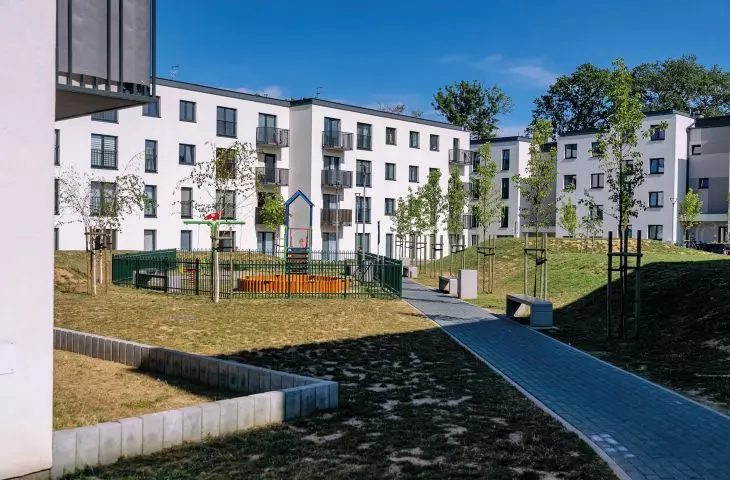Article fromA&B 09|2022 issue
Joanna Erbel and Zuzanna Mielczarek argue that both nationally and locally, authorities have adequately prepared tools for conducting housing policies - long-term and interventionist. What are these options, where have they been successfully implemented, and why are they so rarely used?
Alicja Gzowska:Zuza, recently in your article for Krytyka Polityczna [co-authored by Kamil Trepka, 15.06.2022 - editor's note] you published information that in 2021 almost 235,000 apartments were completed in Poland, of which about 1,800 were realized by the Polish Real Estate Development Fund (PFRN). Is this the scale of housing policy-making in Poland?
Zuzanna Mielczarek:This is too much of a generalization. PFRN is just one piece of the puzzle, mainly responsible for the implementation, in cooperation with local governments, of housing for rent. Rents are market-based, but subsidies can be applied for, so this is an option aimed at the middle class.
Zuzanna Mielczarek - Architect, architecture researcher. Specialist for innovative and social projects at PFR Real Estate. At the National Institute of Architecture and Urbanism, she curates exhibitions and popularization projects. A graduate of the Faculty of Architecture in Delft, the Netherlands, she is a doctoral student at the Faculty of Architecture of the Warsaw University of Technology in the field of inclusive housing. Together with Kamil Trepka, she hosts Krytyka Polityczna's Housing Podcast.
© Private Archive
Alicia:So accessible rental housing under the Housing Plus program?
Zuzanna:Yes - as part of the housing policy, through which a new fabric is created; in addition to the PFRN, there are, for example, Social Housing Associations (TBS) or currently Social Housing Initiatives (SIM).
Joanna Erbel:Housing Plus was one of the elements of the National Housing Program launched in 2016. Bank Gospodarstwa Krajowego's subsidiary BGK Nieruchomości (now PFR Nieruchomości), which was established earlier, during the Civic Platform era, to implement the Housing for Rent Fund program, was also involved in its implementation.
Joanna Erbel - Sociologist, urban activist, housing expert. Founder of the Blisko Foundation dedicated to supporting local activism and creating knowledge on housing innovation. She coordinated the preparation of the housing policy and the Housing2030 program for the city of Warsaw. From 2017 to 2020, she was in charge of the topic of housing innovation at PFR Real Estate. Member of the Council of the Rental Market Foundation. Member of the Board of Directors of PLZ Cooperative. Leader of the self-governance club at the CoopTech Hub, the first cooperative technology center in Poland, which aims to create a community based on trust by digitally rebooting cooperatives and building a local cooperative ecosystem. Co-author of the CTH reports Cooperative Recovery Plan (2021) and Cooperative Transformation (2022). Author of the books "Beyond Ownership. Toward a successful housing policy" (2020) and "Leaning into the future. How to change the world for the better" (2022). Collaborator with the A/Types Foundation, which works for neurodiversity.
© Private Archive
Alicia:So we have continuity?
Joanna:Yes, in a way it's a coherent vision, but there are differences, for example, in terms of getting to ownership. The Rental Housing Fund was aimed at this mythical mobile middle class that would travel between big cities, and was the first step toward rental housing. After all, tying people down with loans to housing is the opposite of mobility. Had it not been for this program and the rather time-consuming procedures involved in establishing the BGK Real Estate company (it took two years), Law and Justice would have had to create a structure from scratch, which would have delayed the construction of rental housing managed by a national entity. The picture of this continuity is also obscured by the fact that communication around Housing Plus has been uneven and variable. The company talked about rental housing with rent other than commercial, but nevertheless set at such a level that these would be self-financing investments with a profit for BGK. At the same time, some Law and Justice politicians - including Minister Andrzej Adamczyk - traveled around Poland and said that these would be low-cost housing, such as communal housing, which caused a great deal of tension.
New eco-district in Chrzanów, architectural and urban planning concept (design: Aleksandra Wasilkowska)
© illustrations courtesy of Chrzanów Municipality
Zuzanna:In the public debate, this program often functions as a failure, while last year it really gained momentum and quite a few investments were made. PFR Real Estate alone has built more than 5,000 apartments since its inception, and in the face of the crisis every apartment is at a premium.
Joanna:Tensions also stem from the promise of 100,000 apartments, unrealistic to fulfill with a fledgling program. There are also unfulfilled expectations on the subject of several thousand apartments that were to be built on PKP land. The largest of these - Wolne Tory in Poznań and Odolany in Warsaw - have not been built. In addition, the rules affecting costs have changed - when Miroslaw Barszcz came up with the guidelines for this program at the beginning, the land plots to BGK were to be contributed non-commercially, in-kind, similar to TBS, which would deduct roughly 20-30 percent of the price of an apartment.
Zuzanna:The PFR Real Estate Company manages the assets of two investment funds - the Housing for Rent Fund and the Housing for Development Fund. The first is a commercial offering. Under the second, the market portion of the government housing program is implemented. In the latter, rents are market-based, but tenants can apply for rent subsidies. They range from 300 to as much as 800 zlotys a month, and that's the social component.
New eco-district in Chrzanów, architectural and urban design concept (design: Aleksandra Wasilkowska).
© illustrations courtesy of Chrzanów Municipality
Joanna:Yes, the idea was to increase their availability without disrupting the commercial model, without increasing the state's debt. That's why it's not investments that are carried out with subsidies. The Housing to Start program reduces the rent, but only for fifteen years. Another topic is the issue of getting to ownership. At one stage, access to ownership was supposed to work only in small towns - where it is in the interest of the municipality to "tie" people to the land. There were also differences in the approach to these two pillars at the project level. For the Rental Housing Fund, ready-made projects were purchased, while Housing for Development, formerly part of Housing Plus, is based mainly on projects made from scratch and standards set internally.
Zuzanna:Not even only within the company - some of the investments that are already under construction (e.g. Wroclaw Kolejowa - design: B2 Studio; Nowy Nikiszowiec - design: 22Architekci or the housing estate in Katowice on Korczaka Street - design : Kuryłowicz & Associates) are based on ready-made projects.: Kuryłowicz & Associates), were selected in architectural competitions organized, among others, with SARP and city representatives serving on the jury. The tradition of competitions continues now, with a competition for an accessible playground, organized with the Integration Foundation.
Joanna: The assumptions about the quality of the space were ultimately similar for both funds. The Rental Housing Fund was also about creating standards and making sure that these apartments were cheap to maintain. I wrote about this in my book "Beyond Ownership."
New eco-district in Chrzanów, architectural and urban design concept (design: Aleksandra Wasilkowska)
© illustrations courtesy of Chrzanów Municipality
Alicia:How many apartments are being built from this Fund?
Susanna:In 2021, 80 apartments from the Rental Housing Fund were handed over, and a total of more than 1,900 over the life of the program. In turn, in 2022, construction began on two more projects that were not purchased ready-made - a total of about 380 apartments in Poznań and Łódź.
Joanna:The Housing for Rent Fund program was created to pave the way for the commercial rental market, and it was under this program that institutional rental was later introduced, the legal framework was prepared. Here the success was the development of new legal solutions, not the volume of housing itself.
Nowy Nikiszowiec estate (design: 22architekci)
photo: PFR Real Estate
Alicia: We have quite a shortage here, all the more acute in view of the influx of refugees from Ukraine.
Zuzanna: It's true, the problem is a shortage of available housing, public housing or other social forms for the Polish residents themselves, so this resource is even less able to respond to the needs of newcomers. That's why in this first wave of refugees from Ukraine there was a social reaction of taking these people under their own roofs, because in principle there was no other solution.
Joanna: It's hard to expect there to be empty apartments for the 2 million people fleeing.
Zuzanna: PFRN has provided such people with apartments in Krakow, Debica and Minsk Mazowiecki, but this is a temporary solution. Long-term systemic solutions on a larger scale are lacking. Probably, a solution could be the activation of vacant communal housing.
Nowy Nikiszowiec estate (design: 22architekci)
photo: PFR Real Estate
Joanna: We had such an idea here in Mokotow. As a result of a popular movement, the resources were thoroughly recognized and in a short time it turned out that we had more than forty large, at least two-room apartments. We proposed that the district authorities, specifically the Real Estate Management Board (ZGN), allow us, as residents of the area, to help renovate these apartments - in a formula that is familiar to the municipality in the form of a local initiative: the community gives its labor, the municipality contributes what it has, i.e. a square or a vacant lot, and someone throws in their money, if necessary. We assumed that in this particular case the know-how could be given by the community with architectural training, and the materials would be donated by construction companies. And this was an idea that received no response from the office at all.
Zuzanna: It's frightening that the city is unwilling to use its capital of strength and willingness on housing projects. Our friends in Ivano-Frankivsk are implementing the Co-HATY project (which we showed together with Kacper Kępinski at the National Institute of Architecture and Urban Planning exhibition, "Polyperiphery"), exactly such an action in response to the increase in domestic migration to that city. They are renovating the vacant buildings together with the people who will inhabit them, in cooperation with the university and the city. This is very advanced and is starting to have a system framework, they are getting investors.
Joanna: There is also such a formula in Poland, it's called "apartments for renovation." In Warsaw, it has failed to be implemented. The main argument is that the quality of replacing installations or more serious things that residents there would like to do may not be acceptable to the authority. In Gdansk, such a program works.
Nowy Nikiszowiec housing development (design: 22architekci)
photo: PFR Real Estate
Susanna: So it's easier for the apartments to stand empty.
Joanna: ...and continue to deteriorate, because, as we know, unused apartments are more likely to become overgrown with fungus than those that someone takes care of.
Zuzanna: Vacant land of all kinds, not only apartments, but also office buildings and shopping centers, have the greatest potential for housing policy. Not just ad-hoc in the face of the crisis. The skyscraper-office building typology has a very high potential to become cohousing housing permanently. I think this solution will soon come on its own, as a result of changes in the ways of working, shopping there will be a lot of empty buildings left, which usually have good locations in the center or are well connected.
Joanna:They are better connected than most new housing developments.
Zuzanna:It's funny that it could happen that habitation will move to abandoned buildings, back to city centers, and that housing estates in the suburbs will start to depopulate.
Prefabricated housing estate in Toruń on Okólna Street, PFR Nieruchomości (design: S.A.M.I Architekci, construction: Pekabex Bet)
photo: PFR Nieruchomości
















































